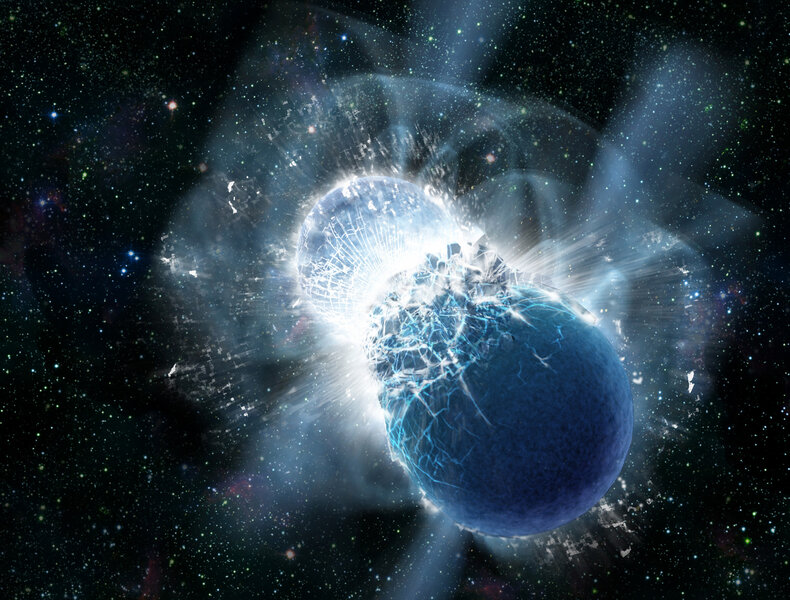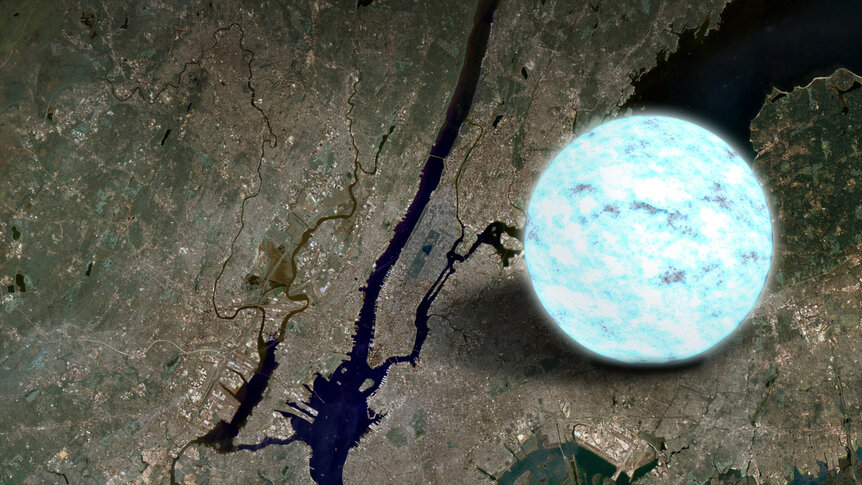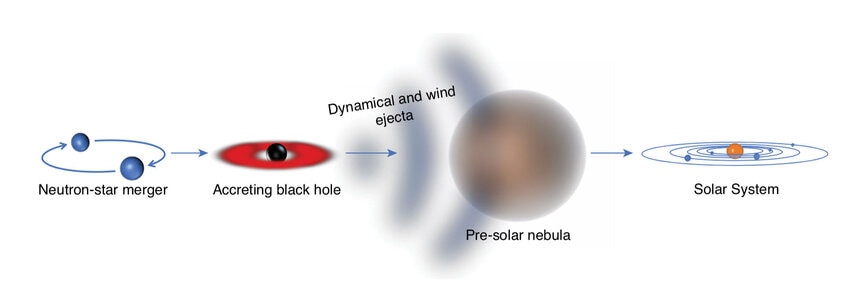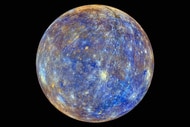Create a free profile to get unlimited access to exclusive videos, sweepstakes, and more!
A nearby binary neutron star collision may have seeded the early solar system with gold
In a new study, astronomers have found that a small fraction of all the gold on planet Earth was likely formed in a single, catastrophic, and very weird event: The merger of two neutron stars. The material blasted out from the ensuing explosion mixed with the stuff that formed the Sun and planets, and, eventually, us. Literally, you and me.
What caught my eye about this new work is that this explosion would have happened just before the collapse of the nebula that formed the Sun and planets, less than 100 million years earlier (that’s an eye blink in cosmic time). Not only that, it would’ve had to have been relatively close by, only about 1,000 light years away.
That’s pretty close, astronomically speaking! If something like this happened now it would far outshine Venus in the night sky, and be easily visible in broad daylight.
The astronomers looked at a special family of elements called r-process elements. These are formed when some already-existing atom absorbs a bunch of neutrons rapidly in its nucleus. When the nucleus of an atom suddenly gets a bunch of neutrons added to it, it responds by immediately decaying radioactively, creating two or more lighter nuclei, and these will tend to have extra neutrons in them. Those elements may be radioactive as well, but they generally stick around a lot longer: These are the r-process elements.
You may have heard of some of them, like plutonium, uranium, iodine, and gold. So yeah, while the process to make them may seem esoteric, it’s actually pretty useful to us now.
To get an atomic nucleus to absorb a bunch of neutrons rapidly, you need fairly extreme conditions, like temperatures of a billion degrees and densities of free neutrons around a trillion trillion of them per cubic centimeter. You’d never find that many just floating around in space, but densities like that are common in certain cosmic explosions like supernovae (exploding stars), and when neutron stars merge. And hey, those are pretty hot, too, so these are where we think most r-process elements come from.
Neutron stars themselves are formed when a massive star explodes. The core collapses, and if it has just the right mass all the electrons and protons in its core merge to become neutrons (note: I am skipping about a hundred steps here to simplify things). What’s left is an object with roughly the mass of a star but compressed into a ball only a dozen or so kilometers across. This neutron star is so dense that a lump of it the size of a six-sided die would outweigh all the cars in the United States combined.
Sometimes stars are born are pairs orbiting each other, called binary systems. If there are two massive stars like this, they can each form a neutron star when they explode. These very slowly spiral together, and after a billion years or three they merge. This generally creates two things: A huge explosion and a black hole. The explosion isn’t quite as powerful as an exploding star, but it’s still pretty beefy, and it’s in this explosion that the r-process elements are made. Some of this material is blasted away in the explosion, and some is blown away by a fierce wind driven by the post-explosion black hole.
I’ll note that this was all theoretical until 2017, when just such an event was witnessed, and the resulting observations indicated that quite a bit of gold was made in the event. So yay! It looks like we’re on the right track.
Now we can put this all together. Our solar system formed about 4.6 billion years ago out of a gas cloud that collapsed to make the Sun and planets. It was presumably mostly hydrogen and helium — the most abundant elements in the Universe — but also had other stuff in it like iron, carbon, and so on. That stuff would have either been in the nebula in the first place, or was injected by events going on around it, like supernovae and neutron star mergers.
Once the Earth formed this material got all jumbled up in the planet, making it hard to know what all the abundance ratios were originally, but it turns out we can cheat and look at meteorites. Some of these formed at the same time the solar system did, and haven’t changed since then.
Looking at meteorites, scientists find that about the total amount of r-process elements in the solar system should be about 1023 kilograms — roughly the mass of Mercury. In the new work, the astronomers looked to see if a sort of constant low-level background events in our galaxy could produce this amount of r-process material, and found that the numbers were not consistent.
That means that some other, more rare event must have been what injected all those elements into the pre-solar nebula. Knowing how often massive stars form in pairs, how long they take to explode, and what happens to the neutron star binary after, you can theoretically predict how often they happen in the galaxy. Assuming they’re distributed randomly, it’s then possible to run simulations to see what the odds are of one being close enough and occurring at the right time to give us the numbers that match observations.
That’s what the astronomers did. They found that the best match was a single neutron star merger about 80 million years before the nebula collapsed to form the solar system, and it happened just about 1,000 light years away. In the end, about 0.3% of all r-process elements in the solar system may have come from this single event!
What does that mean? Well, it means that a whole bunch of other, farther events probably created the bulk of these elements in the solar system, but a single nearby one contributed a substantial amount. They found that if you wear a gold ring, about 10 milligrams of it came from this single event! At current prices, this is about 40 cents worth of gold.
But knowing it came from the collision of two neutron stars? Priceless.
Mind you, there are other elements made in this event as well, including some isotopes of iodine. You probably have a few dozen micrograms of this in your body right now; iodine created when two massive and dense balls of cosmic material merged and exploded, seeding the surrounding regions of the galaxy with these rare elements… including our own stellar nursery.
Carl Sagan said it best: We are star stuff. He was both poetically and prosaically correct.
And we are not only star stuff, we are neutron star stuff.

















